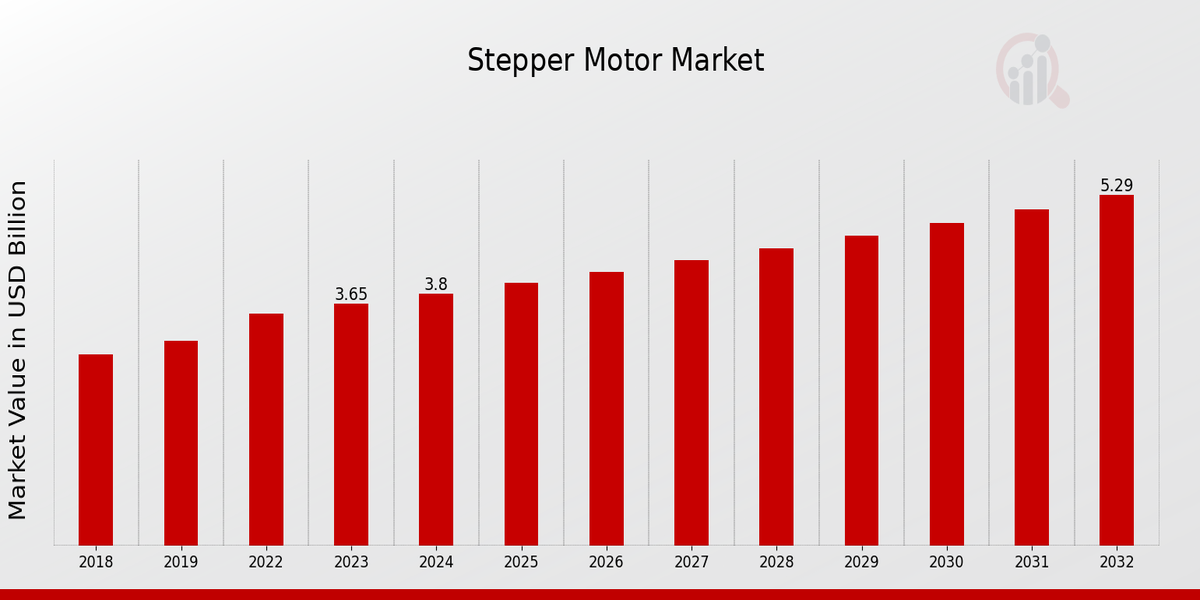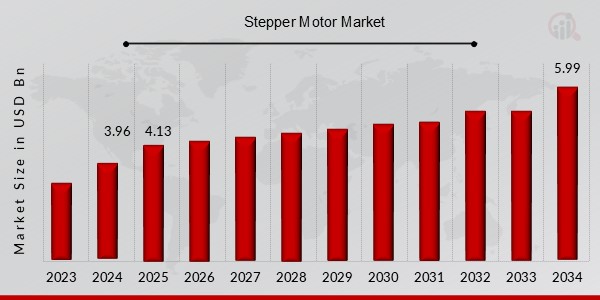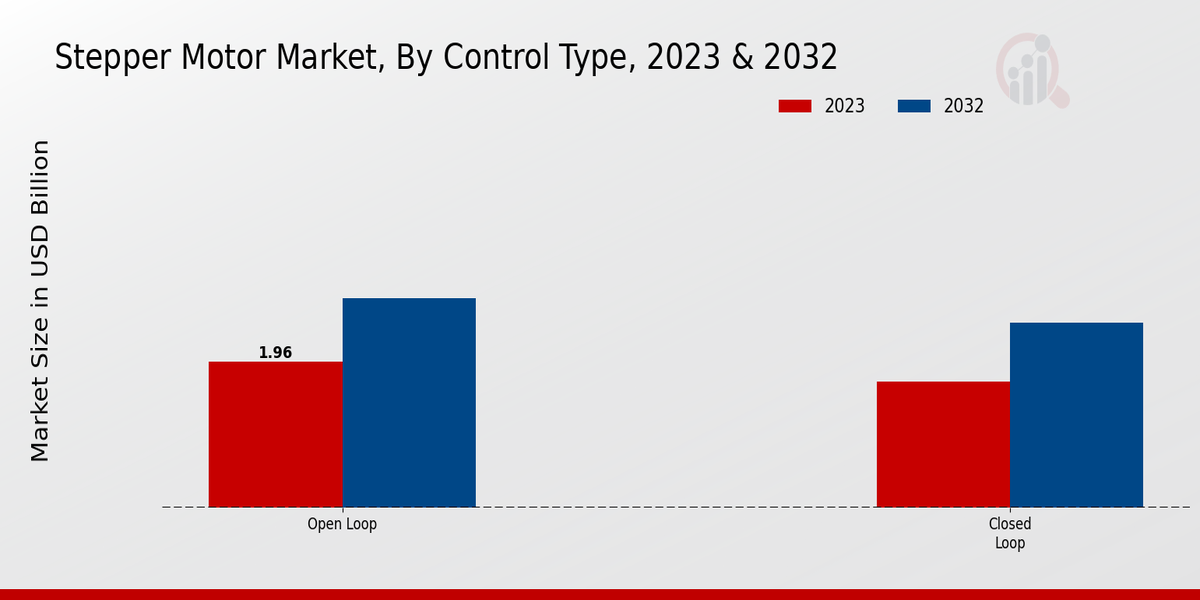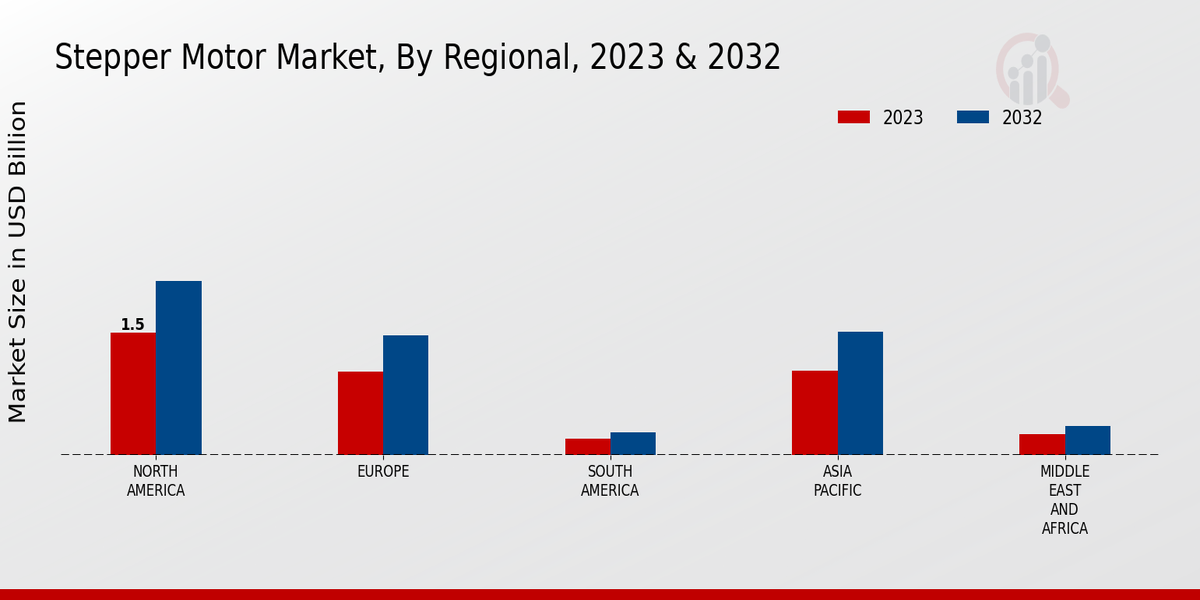Global Stepper Motor Market Overview
The Stepper Motor Market Size was estimated at 3.96 (USD Billion) in 2024. Stepper Motor Industry is expected to grow from 4.13 (USD Billion) in 2025 to 5.99 (USD Billion) by 2034, at a CAGR (growth rate) is expected to be around 4.22% during the forecast period (2025 - 2034)
Key Stepper Motor Market Trends Highlighted
The stepper motor market is currently witnessing robust growth driven by the rising demand for automation across various industries, including manufacturing, automotive, and healthcare. As production processes become increasingly automated, the need for precise motion control is paramount, making stepper motors a critical component in machines and systems. Additionally, the growing adoption of 3D printing technology, which relies heavily on stepper motors for accurate positioning and movement, has added a new layer of demand. Furthermore, the trend toward smart devices and IoT applications is creating opportunities for stepper motors that can operate efficiently in compact, low-power environments.
Recent trends indicate a shift towards brushless and hybrid stepper motors, characterized by improved performance and energy efficiency. Technological advancements are facilitating the development of smart stepper motors with integrated control systems, catering to the need for enhanced accuracy and precision. Opportunities lie in expanding applications within robotics and CNC machinery, where stepper motors provide critical functionality for task execution and automation. The increasing focus on electric vehicles also presents significant opportunities, as stepper motors are finding applications in various systems within these vehicles, contributing to increased efficiency and performance.
As industries continue to evolve and seek innovative solutions to enhance productivity and efficiency, the stepper motor market is poised for substantial growth. The emergence of new technologies, coupled with an ever-growing need for precision in automation, positions stepper motors as a vital component in the advancement of modern manufacturing and technological processes.


Source: Primary Research, Secondary Research, MRFR Database and Analyst Review
Stepper Motor Market Drivers
Growth in Automation and Robotics
The Stepper Motor Market Industry is expected to experience significant growth due to the rising demand for automation and robotics across various sectors. The integration of stepper motors into automated systems enhances precision, control, and efficiency, making them indispensable for modern manufacturing processes. Industries such as automotive, electronics, packaging, and medical technology increasingly rely on robotic solutions that employ stepper motors to improve operational efficiency and accuracy.
Automation not only boosts productivity but also reduces the likelihood of human error, leading to enhanced quality of products and services. The trend toward smart factories and Industry 4.0 continues to drive investments in automated systems that utilize stepper motors, which are well-suited for applications requiring precise movements and positioning. As manufacturers seek to streamline operations and reduce costs, the demand for advanced stepper motors that offer higher torque, improved thermal performance, and better speed control will continue to grow.
Moreover, the climate for sustained industrial growth and technological advancement supports the need for reliable automation solutions, thus propelling the Stepper Motor Market Industry forward. The continuous innovation in motor technology, such as the development of hybrid stepper motors that combine the advantages of both permanent magnet and variable reluctance designs, further enhances the appeal of these motors within new machinery and systems. As companies strive for greater efficiency, they are likely to allocate considerable budgets to procure state-of-the-art stepper motors, highlighting their essential role in an evolving industrial landscape.
Rising Demand from Consumer Electronics
The Stepper Motor Market Industry is significantly influenced by the surging demand for consumer electronics. With technological advancements, the integration of stepper motors in devices such as printers, cameras, and smartphones is becoming commonplace. Their ability to provide precise motion control and energy efficiency makes them a preferred choice for these applications. As consumer electronics continue to evolve, manufacturers are increasingly adopting stepper motors to enhance the functionality and performance of their products.
Growing Emphasis on Energy Efficiency
The Stepper Motor Market Industry is also driven by the increasing emphasis on energy efficiency across various applications. Companies are now more inclined towards using stepper motors as they offer better energy savings compared to traditional motors. This trend aligns with global sustainability goals and regulations aimed at reducing energy consumption. As industries prioritize eco-friendly practices, the demand for efficient stepper motors will likely continue to rise.
Stepper Motor Market Segment Insights
Stepper Motor Market Control Type Insights
The control type segment of the Stepper Motor Market is critical to understanding the overall landscape of this industry, which is projected to witness significant growth. The primary classifications within this segment are open-loop and closed-loop control systems, each having unique advantages and applications. Open Loop systems are characterized by their simplicity and cost-effectiveness, making them popular in various applications such as basic automation, 3D printers, and CNC machines. In the Open Loop control mode, the stepper motor operates on preset commands without feedback from the system.
This control type is generally suitable for applications where high precision and torque are not critical since it can experience issues with missed steps under heavy load or external disturbances. The Open Loop segment contributes a notable share to the Stepper Motor Market revenue as it accommodates a broad array of inexpensive applications, thereby appealing to budget-conscious manufacturers. Conversely, the closed-loop control system is increasingly gaining traction due to its enhanced performance and reliability. This system integrates feedback mechanisms that actively monitor the motor's position and adjust its actions accordingly.
The Closed-loop configuration is particularly advantageous in applications that require high precision, such as robotics, medical devices, and aerospace components. Closed-loop motors demonstrate superior torque performance, reduced power consumption, and the ability to recover from disturbances, making them an attractive option for industries demanding high accuracy and reliability. As the Stepper Motor Market industry expands, a growing number of organizations are transitioning toward closed-loop systems, thereby accelerating the shift in market dynamics.
According to recent Stepper Motor Market statistics, the Closed Loop segment is increasingly dominating market growth, with projections showing its market share rising significantly in the coming years. As technology advances, manufacturers are developing more sophisticated closed-loop systems that leverage advanced algorithms and artificial intelligence for improved performance, further driving their adoption. Market data suggests that in 2024, the revenue generated from closed-loop stepper motors will account for a substantial portion of the Stepper Motor Market, reflecting an ongoing trend toward automation and increased operational efficiency.
Furthermore, the evolution of industrial automation technologies is propelling the demand for both control types, but particularly the Closed Loop systems, which are becoming integral in smart factory setups. Innovations in sensing technologies also enhance closed-loop systems' capabilities, allowing for more precise motion control and real-time data monitoring. This synergy of advancements positions the closed-loop segment not only as a leader in terms of performance but also as a key player in the future trajectory of Stepper Motor Market segmentation.
As the market landscape evolves, manufacturers must consider the shift towards more advanced Closed-loop systems, which aligns with global trends of increasing automation and smart technologies. The rising demand for precise and efficient motion control solutions across various sectors is expected to continue fueling growth in both segments Open Loop and Closed Loop control types. Collectively, this dynamic presents a compelling case for stakeholders in the Stepper Motor Market to invest in understanding these control types deeply and how they fit into the broader context of industry applications, market growth, and customer needs.

Source: Primary Research, Secondary Research, MRFR Database and Analyst Review
Stepper Motor Market Phase Insights
The Phase segment of the Stepper Motor Market is characterized by a diverse array of motor types, including Two-Phase, Three-Phase, and Multi-Phase systems. Two-phase stepper motors dominate the market due to their simplicity and cost-effectiveness, making them ideal for applications that require moderate precision. Meanwhile, Three-Phase stepper motors offer superior torque and efficiency, thereby catering to higher-performance applications. Multi-phase stepper motors, although less common, are gaining traction for their ability to provide enhanced precision and control in complex applications.
According to recent Stepper Motor Market data, the market is projected to reach approximately USD 4.13 billion by 2024, signaling robust market growth driven by advancements in automation and robotics. The Stepper Motor Market segmentation reveals significant opportunities within industrial automation and consumer electronics, bolstered by increasing demand for precision motion control. Comprehensive Stepper Motor Market statistics indicate that the Phase segment will play a crucial role in shaping the future landscape of the Stepper Motor Market industry.
Stepper Motor Market Motor Size Insights
In the Stepper Motor Market, segmentation by motor size reveals significant insights, particularly in the NEMA 17, NEMA 23, and NEMA 34 categories. As of 2024, the Stepper Motor Market revenue is projected to witness substantial growth, driven by the increasing adoption of automation in various industries. NEMA 17 motors are favored for their compact design, offering an optimal balance of torque and size, making them ideal for 3D printers and robotics.
NEMA 23 motors provide higher torque and are commonly used in CNC machines and industrial applications, reflecting the diverse needs across the Stepper Motor Market industry.Meanwhile, NEMA 34 motors, known for their robustness and high power capabilities, cater to applications requiring significant torque. This diversification within the motor size segment contributes to the overall market growth, as Stepper Motor Market statistics indicate rising demand across automotive, manufacturing, and aerospace sectors. The Stepper Motor Market data highlights that as automation and sophisticated control systems proliferate, the market for these specific motor sizes will continue to expand, underscoring their critical role in technological advancement.
Stepper Motor Market Application Insights
The Stepper Motor Market is witnessing significant growth across various applications, including Industrial Automation, Medical Devices, Semiconductor Equipment, Robotics, and Aerospace and Defense. In 2024, the market is projected to boost its revenue due to increasing demand for automation in manufacturing processes, which is estimated to grow at a robust rate. Medical devices are increasingly incorporating stepper motors for precise movement and control, supporting the rising trend in healthcare automation.
Furthermore, the semiconductor sector relies heavily on stepper motors for precision in fabrication processes.Robotics applications are also a key driver, with advancements in robotic technologies leveraging stepper motors for enhanced performance. The Aerospace and Defense sector's expanding need for reliable motion control systems further supports the growth of the Stepper Motor Market. Collectively, these segments contribute to the overall Stepper Motor Market statistics and segmentation, indicating a positive trajectory for market growth and a promising outlook for stakeholders in this industry.
Stepper Motor Market Mounting Type Insights
The mounting type segment of the Stepper Motor Market is crucial for various applications across industries. In 2024, the revenue from flange mount configurations is projected to experience significant growth due to their ease of installation and stability, particularly in the automation and robotics sectors. Panel mount stepper motors are gaining traction as they are ideal for space-constrained environments, often utilized in medical devices and manufacturing equipment.
Shaft mount motors, known for their direct drive capabilities, are essential in applications requiring high torque and precision.The Stepper Motor Market statistics indicate that these three mounting types are fundamental in driving market growth. Collectively, the Stepper Motor Market segmentation reflects the diverse needs of industries, showcasing the versatility and adaptability of different mounting types to fulfill specific operational requirements. As demand rises, the analysis of Stepper Motor Market data reveals a robust trajectory for mounting types, aligning with broader trends in the Stepper Motor Market industry.
Stepper Motor Market Regional Insights
In the Stepper Motor Market, regional segmentation reveals significant insights driving market growth. North America is projected to maintain a substantial share, fueled by advancements in automation and robotics, leading to an increase in Stepper Motor Market revenue. Europe will continue to innovate with electric vehicles and industrial applications, enhancing the Stepper Motor Market industry landscape.
The Asia-Pacific (APAC) region is anticipated to experience rapid expansion, particularly in manufacturing sectors, contributing to impressive Stepper Motor Market statistics.South America, while smaller, shows potential for growth through investments in industrial automation. The Middle East and Africa (MEA) region is also expected to witness growing demand, driven by infrastructure development and technological investments, impacting the Stepper Motor Market segmentation positively. Overall, the Stepper Motor Market data indicates a diverse range of opportunities across these regions, each contributing uniquely to the market's trajectory.

Source: Primary Research, Secondary Research, MRFR Database and Analyst Review
Stepper Motor Market Key Players And Competitive Insights:
The competitive insights of the Stepper Motor Market reveal a dynamic landscape characterized by a diverse array of manufacturers and suppliers. This market segment is increasingly defined by innovation, with many firms focusing on advanced technologies and solutions to enhance performance across various applications. A strong emphasis is placed on energy efficiency, precision, and operational reliability, which drives the development of new products tailored to the evolving needs of end-users. The Stepper Motor Market industry is influenced by trends that include automation, robotics, and the Internet of Things, compelling key players to invest in research and development to maintain their competitive edge.
As the demand for high-performance motors increases in sectors such as manufacturing, automotive, and healthcare, the presence of key players dedicated to fulfilling these requirements becomes evident. Detailed knowledge of the market's competitive landscape enables companies to position their products effectively and respond promptly to market demands.One leading company in the Stepper Motor Market is Nidec Corporation, which has established itself as a formidable force in the industry. Nidec Corporation is renowned for its wide-ranging portfolio that includes stepper motors designed for a variety of applications, ranging from consumer electronics to industrial machinery.
The company emphasizes customization by offering tailored solutions that meet specific customer requirements, subsequently augmenting its market presence. Nidec Corporation's continued investment in advanced manufacturing techniques and cutting-edge technology developments reinforces its commitment to high-quality product offerings. Additionally, the organization's strategic partnerships and collaborations further enhance its research capabilities, allowing it to pioneer innovations that address future market needs while also elevating the overall effectiveness of its stepper motor products.A prominent competitor in the Stepper Motor Market is Japan Servo, known for its innovative design and high-performance motor solutions.
Japan Servo focuses significantly on the integration of digital technology with traditional stepper motors, aiming to improve precision and control in motion applications. This company adopts a customer-centric approach, ensuring its products align closely with market demand, particularly in automation and robotics applications. Japan Servo's continuous drive for improvement through rigorous testing and quality assurance processes has positioned it as a reliable choice for industry professionals. The company's research initiatives emphasize both performance enhancement and energy efficiency, which are critical factors for users across various sectors. Through its commitment to excellence and adaptation to industry trends, Japan Servo plays a vital role in the competitive landscape of the Stepper Motor Market, challenging others to elevate their standards in response.
Key Companies in the Stepper Motor Market Include
- JVL Industriess
- Nanotec Electronic GmbH
- Anaheim Automation
- Portescap
- Oriental Motor Company
- Allied Motion Technologies, Inc.
- MinebeaMitsumimineparaJapan Servo Co., Ltd.
- Schneider Electric
- Trinamic Motion Controll
- Kyocera Syntec
- Rockwell Automation, Inc.
- Sanyo Denkin
- Mclennan Servo
- Lin Engineering
Stepper Motor Market Industry Developments
The Stepper Motor Market is witnessing significant expansion, with a valuation anticipated to reach approximately 3.65 billion USD in 2024 and projected to grow to about 5.29 billion USD by 2032, reflecting a compound annual growth rate (CAGR) of 4.22%. Recent developments highlight increasing applications in the automation and robotics sectors, driven by the demand for precision motion control systems across diverse industries such as manufacturing, medical devices, and automotive. The rise of Industry 4.0 and the integration of smart technologies are further propelling market growth, coupled with advancements in product design and energy efficiency.
Additionally, regional dynamics show a surge in adoption in Asia-Pacific, primarily due to growing industrialization and investments in infrastructure. The emergence of eco-friendly motor technologies and the shift towards electric motors in various applications underscore a transformative period for the industry. Recent challenges include supply chain disruptions and fluctuations in raw material costs, which may impact pricing and availability. However, innovation in motor technology continues to foster opportunities for market players.
Stepper Motor Market Segmentation Insights
-
Stepper Motor Market Control Type Outlook
- Open Loop
- Closed Loop
-
Stepper Motor Market Phase Outlook
- Two-Phase
- Three Phase
- Multi-Phase
-
Stepper Motor Market Motor Size Outlook
- NEMA 17
- NEMA 23
- NEMA 34
-
Stepper Motor Market Application Outlook
- Industrial Automation
- Medical Devices
- Semiconductor Equipment
- Robotics
- Aerospace and Defense
-
Stepper Motor Market Mounting Type Outlook
- Flange Mount
- Panel Mount
- Shaft Mount
-
Stepper Motor Market Regional Outlook
- North America
- Europe
- South America
- Asia Pacific
- Middle East and Africa
Stepper Motor Market Report Scope
| Report Attribute/Metric |
Details |
|
Market Size 2024
|
3.96 (USD Billion)
|
|
Market Size 2025
|
4.13 (USD Billion)
|
|
Market Size 2034
|
5.99 (USD Billion)
|
|
Compound Annual Growth Rate (CAGR)
|
4.22% (2025 - 2034)
|
|
Report Coverage
|
Revenue Forecast, Competitive Landscape, Growth Factors, and Trends
|
|
Base Year
|
2024
|
|
Market Forecast Period
|
2025 - 2034
|
|
Historical Data
|
2020 - 2024
|
| Market Forecast Units |
USD Billion |
| Key Companies Profiled |
JVL Industriess, Nanotec Electronic GmbH, Anaheim Automation, Portescap, Oriental Motor Company, Allied Motion Technologies, Inc., MinebeaMitsumimineparaJapan Servo Co., Ltd., Schneider Electric, Trinamic Motion Controll, Kyocera Syntec, Rockwell Automation, Inc., Sanyo Denkin, Mclennan Servo, Lin Engineering |
| Segments Covered |
Control Type, Phase, Motor Size, Application, Mounting Type, Regional |
| Key Market Opportunities |
Industrial automation growth Electric vehicle adoption Robotics sector expansion Renewable energy systems integration Smart home technology advances |
| Key Market Dynamics |
Growing demand in automation Rising adoption of robotics Technological advancements in motor efficiency Increasing applications in 3D printing Expanding automotive sector usage |
| Countries Covered |
North America, Europe, APAC, South America, MEA |
Frequently Asked Questions (FAQ) :
The estimated market size of the Stepper Motor Market in 2024 is 3.96 billion USD.
The projected market size for the Stepper Motor Market by 2034 is 5.99 billion USD.
The expected CAGR for the Stepper Motor Market from 2025 to 2034 is 4.22%.
Regions such as North America, Europe, and Asia-Pacific are expected to drive growth in the Stepper Motor Market.
Primary applications of stepper motors include automation, robotics, and medical equipment.
Key competitors in the Stepper Motor Market include major players such as Nidec, Oriental Motor, and Schneider Electric.
The cumulative market size for key competitors in the Stepper Motor Market is expected to significantly contribute to the overall growth by 2034.
The Stepper Motor Market size increases from 3.96 billion USD in 2024 to 5.99 billion USD in 2034.
Growth factors include rising demand for automation and advancements in technology across various sectors.
The Stepper Motor Market is crucial for businesses in the automation sector due to its role in enhancing precision and efficiency in applications.

















